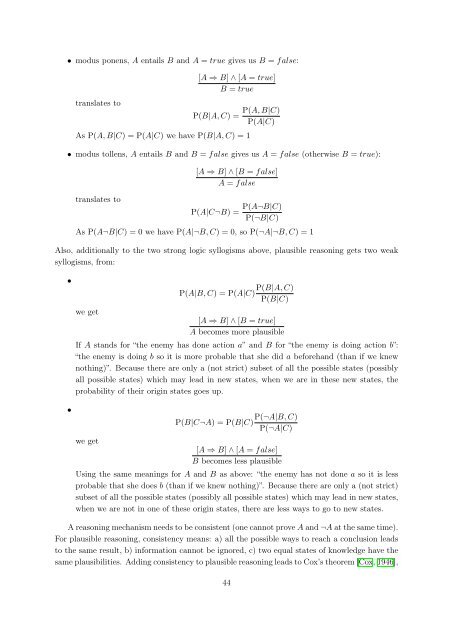Bayesian Programming and Learning for Multi-Player Video Games ...
Bayesian Programming and Learning for Multi-Player Video Games ...
Bayesian Programming and Learning for Multi-Player Video Games ...
You also want an ePaper? Increase the reach of your titles
YUMPU automatically turns print PDFs into web optimized ePapers that Google loves.
• modus ponens, A entails B <strong>and</strong> A = true gives us B = false:<br />
translates to<br />
[A ⇒ B] ∧ [A = true]<br />
B = true<br />
P(B|A, C) =<br />
As P(A, B|C) = P(A|C) we have P(B|A, C) = 1<br />
P(A, B|C)<br />
P(A|C)<br />
• modus tollens, A entails B <strong>and</strong> B = false gives us A = false (otherwise B = true):<br />
translates to<br />
[A ⇒ B] ∧ [B = false]<br />
A = false<br />
P(A|C¬B) = P(A¬B|C)<br />
P(¬B|C)<br />
As P(A¬B|C) = 0 we have P(A|¬B, C) = 0, so P(¬A|¬B, C) = 1<br />
Also, additionally to the two strong logic syllogisms above, plausible reasoning gets two weak<br />
syllogisms, from:<br />
•<br />
•<br />
we get<br />
P(B|A, C)<br />
P(A|B, C) = P(A|C)<br />
P(B|C)<br />
[A ⇒ B] ∧ [B = true]<br />
A becomes more plausible<br />
If A st<strong>and</strong>s <strong>for</strong> “the enemy has done action a” <strong>and</strong> B <strong>for</strong> “the enemy is doing action b”:<br />
“the enemy is doing b so it is more probable that she did a be<strong>for</strong>eh<strong>and</strong> (than if we knew<br />
nothing)”. Because there are only a (not strict) subset of all the possible states (possibly<br />
all possible states) which may lead in new states, when we are in these new states, the<br />
probability of their origin states goes up.<br />
we get<br />
P(¬A|B, C)<br />
P(B|C¬A) = P(B|C)<br />
P(¬A|C)<br />
[A ⇒ B] ∧ [A = false]<br />
B becomes less plausible<br />
Using the same meanings <strong>for</strong> A <strong>and</strong> B as above: “the enemy has not done a so it is less<br />
probable that she does b (than if we knew nothing)”. Because there are only a (not strict)<br />
subset of all the possible states (possibly all possible states) which may lead in new states,<br />
when we are not in one of these origin states, there are less ways to go to new states.<br />
A reasoning mechanism needs to be consistent (one cannot prove A <strong>and</strong> ¬A at the same time).<br />
For plausible reasoning, consistency means: a) all the possible ways to reach a conclusion leads<br />
to the same result, b) in<strong>for</strong>mation cannot be ignored, c) two equal states of knowledge have the<br />
same plausibilities. Adding consistency to plausible reasoning leads to Cox’s theorem [Cox, 1946],<br />
44


